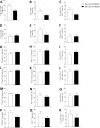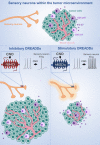Chemogenetic modulation of sensory neurons reveals their regulating role in melanoma progression
- PMID: 34784974
- PMCID: PMC8594104
- DOI: 10.1186/s40478-021-01273-9
Chemogenetic modulation of sensory neurons reveals their regulating role in melanoma progression
Abstract
Sensory neurons have recently emerged as components of the tumor microenvironment. Nevertheless, whether sensory neuronal activity is important for tumor progression remains unknown. Here we used Designer Receptors Exclusively Activated by a Designer Drug (DREADD) technology to inhibit or activate sensory neurons' firing within the melanoma tumor. Melanoma growth and angiogenesis were accelerated following inhibition of sensory neurons' activity and were reduced following overstimulation of these neurons. Sensory neuron-specific overactivation also induced a boost in the immune surveillance by increasing tumor-infiltrating anti-tumor lymphocytes, while reducing immune-suppressor cells. In humans, a retrospective in silico analysis of melanoma biopsies revealed that increased expression of sensory neurons-related genes within melanoma was associated with improved survival. These findings suggest that sensory innervations regulate melanoma progression, indicating that manipulation of sensory neurons' activity may provide a valuable tool to improve melanoma patients' outcomes.
Keywords: Chemogenetics; Melanoma; Neuronal activity; Sensory neurons; Tumor microenvironment.
© 2021. The Author(s).
Conflict of interest statement
The authors have no competing interests to declare.
Figures










Similar articles
-
Ablation of sensory nerves favours melanoma progression.J Cell Mol Med. 2020 Sep;24(17):9574-9589. doi: 10.1111/jcmm.15381. Epub 2020 Jul 20. J Cell Mol Med. 2020. PMID: 32691511 Free PMC article.
-
Increased Resurgent Sodium Currents in Nav1.8 Contribute to Nociceptive Sensory Neuron Hyperexcitability Associated with Peripheral Neuropathies.J Neurosci. 2019 Feb 20;39(8):1539-1550. doi: 10.1523/JNEUROSCI.0468-18.2018. Epub 2019 Jan 7. J Neurosci. 2019. PMID: 30617209 Free PMC article.
-
Chemogenetic Inhibition of Pain Neurons in a Mouse Model of Osteoarthritis.Arthritis Rheumatol. 2017 Jul;69(7):1429-1439. doi: 10.1002/art.40118. Epub 2017 Jun 2. Arthritis Rheumatol. 2017. PMID: 28380690 Free PMC article.
-
The Role of Voltage-Gated Sodium Channels in Pain Signaling.Physiol Rev. 2019 Apr 1;99(2):1079-1151. doi: 10.1152/physrev.00052.2017. Physiol Rev. 2019. PMID: 30672368 Review.
-
[Role of tumor microenvironment in the formation and progression of skin melanoma].Postepy Hig Med Dosw (Online). 2013 May 14;67:413-32. doi: 10.5604/17322693.1049286. Postepy Hig Med Dosw (Online). 2013. PMID: 23756376 Review. Polish.
Cited by
-
ß-Adrenoreceptors in Human Cancers.Int J Mol Sci. 2023 Feb 12;24(4):3671. doi: 10.3390/ijms24043671. Int J Mol Sci. 2023. PMID: 36835082 Free PMC article. Review.
-
TNF-α enhances sensory DRG neuron excitability through modulation of P2X3 receptors in an acute colitis model.Front Immunol. 2022 Aug 12;13:872760. doi: 10.3389/fimmu.2022.872760. eCollection 2022. Front Immunol. 2022. PMID: 36032155 Free PMC article.
-
Neuroendocrine regulations in tissue-specific immunity: From mechanism to applications in tumor.Front Cell Dev Biol. 2022 Aug 22;10:896147. doi: 10.3389/fcell.2022.896147. eCollection 2022. Front Cell Dev Biol. 2022. PMID: 36072337 Free PMC article. Review.
-
Ehrlich Tumor Induces TRPV1-Dependent Evoked and Non-Evoked Pain-like Behavior in Mice.Brain Sci. 2022 Sep 15;12(9):1247. doi: 10.3390/brainsci12091247. Brain Sci. 2022. PMID: 36138983 Free PMC article.
-
Whole bone subcutaneous transplantation as a strategy to study precisely the bone marrow niche.Stem Cell Rev Rep. 2023 May;19(4):906-927. doi: 10.1007/s12015-022-10496-9. Epub 2022 Dec 31. Stem Cell Rev Rep. 2023. PMID: 36585572
References
-
- Amaya F, Wang H, Costigan M, Allchorne AJ, Hatcher JP, Egerton J, Stean T, Morisset V, Grose D, Gunthorpe MJ, et al. The voltage-gated sodium channel Na(v)1.9 is an effector of peripheral inflammatory pain hypersensitivity. J Neurosci. 2006;26:12852–12860. doi: 10.1523/JNEUROSCI.4015-06.2006. - DOI - PMC - PubMed
-
- Ansel JC, Brown JR, Payan DG, Brown MA. Substance P selectively activates TNF-alpha gene expression in murine mast cells. J Immunol. 1993;150:4478–4485. - PubMed
Publication types
MeSH terms
Substances
Grants and funding
LinkOut - more resources
Full Text Sources
Medical
Molecular Biology Databases

